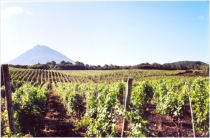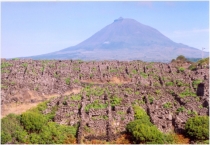The Azores
Wine region: THE AZORES
After the discovery of the Atlantic archipelago during the reign of King Afonso V, his uncle, Henry the Navigator, order the uprooting of vines on the island of Crete so that they could be acclimatised first to Madeira, and then to the Azores. The motive was to capture the important Greek liqueur wine market, thus taking advantage of the position of these islands and the international sailing routes of ships crossing the Atlantic. Planted in corrals to protect the vines from the wind, the vineyards flourished. At the beginning of the 16th century, the Carmelite and Franciscan monks successfully perfected their vitivinicultural techniques. In the 19th century, the level of exports had grown to 20,000 pipes and vineyards covered an area of over 2,000 hectares. Contact with the Hanseatic League, exports via their own “feitoria” (factory) to Brazil, not to mention business with England and Russia, where Pico wine was considered to be the wine of Tsars, revealed outstanding commercial organisation. Starting in 1852, the American Plagues destroyed viticulture.
The market for regional consumption and passing trade was recovered by the American hybrid vines until a few years ago. When initial rebuilding of viticulture and viniculture took place, however, heliothermal properties were obviously not properly taken into account when selecting new grapevine varieties which had to adapt to different growing conditions; neither was the necessity to replace the corrals with other types of windbreaks understood. Thus, lamentably, the restructuring did not result in the desired outcome. While interesting wines such as Biscoitos and Graciosa were produced, yields were lower. Nevertheless, the Cooperativa de Pico (“Pico Cooperative”) labels and the innovative wines of the Curral de Atlantis winery have shown that there may well be a future for the famous wines of the Azores. Others involved in viticulture take advantage of subsidies granted to maintain traditional viticulture in corrals, although this is not economically sustainable, or they are replanting the Jacquez or Cunningham hybrids.
The archipelago of the Azores is situated in the middle of the Atlantic Ocean between the latitudes of 37 and 39.5 north, some 1,600 kilometres from the coast of mainland Portugal. It is made up of nine islands, three of which support vineyard cultivation: Terceira, Pico and Graciosa. The edapho‑climatic conditions of the islands making up this archipelago are characterised by strong winds, stable temperatures owing to the proximity of the sea, and a unique soil completely different from the soils found in Portugal, which is artificially improved with the addition of volcanic ash known locally as “bagacinho”. Located within the contact zone of the North American, Eurasian and African tectonic plates, the Azores is of relatively recent volcanic origin, and therefore its soils are quite shallow, and made up of basaltic rocks, trachytes, andesites and argillaceous formations. The quality and prestige of the wines of the Azores has been acknowledged for a long time and is the primary reason for three of them – “Pico”, “Graciosa” and “Biscoitos” – to have received IPR certification.
Types of vitivinicultural products
Açores IG wines or Açores regional wines: Red and white
BISCOITOS DO and PICO DO wines (VLQPR): liqueur white
GRACIOSA DO wine: White.
Regional Contacts
Technical information: COMISSÃO VITIVINÍCOLA DOS AZORES (“VITIVINICULTURAL COMMISSION OF THE AZORES”) Av. Machado Serpa, 9950‑321 Madalena‑Pico, 292 623 605/6,
Eno‑tourism information: The Azores Wine Route. www.vitiviniculturaatlantica.com, Portal Turismo Açores (The Azores tourism portal): www.azorestourism.com
Cultural information on the wine of the region: Confraria do Vinho do Pico (“Vinho do Pico Society”) Gabinete da Vinha – Parque Natural da Ilha do Pico, Museu do Vinho dos Biscoitos (“Biscoitos Wine Museum”), Canada do Caldeiro 9760‑051 BISCOITOS, Ilha Terceira, Praia da Vitória; Tel. 965667324, Website: www.casaagricolabrum.com; Museu do Vinho do Pico (“Vinho do Pico Museum”), Rua do Carmo Toledos 9950‑364 MADALENA (PICO), Ilha do Pico, Madalena, Tel. 292672276.
Institutions of higher learning and viticultural research: Universidade dos Açores (“University of the Azores”), Angra do Heroísmo Campus, Rua Capitão João d’Ávlia – Pico da Urze; 9700‑042 Angra do Heroísmo, Açores, Portugal. Tel. 295 402 200.
Certification authority: COMISSÃO VITIVINÍCOLA DOS AZORES (“VITIVINICULTURAL COMMISSION OF THE AZORES”) Av. Machado Serpa (Edifício do Serviço de Desenvolvimento Agrário do Pico) 606 – Tel.: 292 623 605/6, Fax: 292 623; 9950‑321 MADALENA (PICO), e‑mail: cvracores@hotmail.pt
Producer and bottler information on wine from the Lisboa region: http://www.ivv.min‑agricultura.pt/np4/1736.html, → Yearbook, page 266.
Designation: IGP “Tejo” Regional wine

Legislation: Ministerial Directive No. 853/2004, Reg. (EC) 1493/99.
Varieties
RED WINES: Agronómica, Aragonez (Tinta Roriz), Cabernet‑Franc, Cabernet Sauvignon, Castelão (Periquita), Complexa, Merlot, Pinot Noir, Rufete, Saborinho, Tinta Barroca, Touriga Franca, Touriga Nacional, Vinhão and Gewurztraminer.
WHITE WINES: Arinto (Pedernã), Bical, Chardonnay, Fernão Pires (Maria Gomes), Galego Dourado, Generosa, Gouveio, Malvasia, Malvasia Fina, Moscatel Graúdo, Riesling, Rio Grande, Seara Nova, Sercial (Esgana Cão), Tália, Terrantez, Verdelho, Viosinho.
AS DOP/ VQPRD

The Azores has not yet received IPR classification;
All IPR wines have the quality guarantee label.
Designation: IPR “Biscoito” VLQPRD
Legislation: Decree‑Law No. 17/94, Reg. (EC) 1493/99.
Varieties:
WHITE WINES: Verdelho, Arinto (Pedernã) and Terrantez
Designation: IPR “Graciosa” VQPRD
Legislation: Decree‑Law No. 17/94, and Reg. (EC) 1493/99.
Varieties:
WHITE WINES: Verdelho, Arinto (Pedernã), Terrantez, Malvasia Fina e Fernão Pires (Maria Gomes).
Designation: IPR “Pico” VLQPRD
Legislation: Decree‑Law No. 17/94, Reg. (EC) 1493/99.
Varieties:
WHITE WINES: Verdelho, Arinto (Pedernã) and Terrantez



